1993 BUICK PARK AVENUE wheel
[x] Cancel search: wheelPage 23 of 340
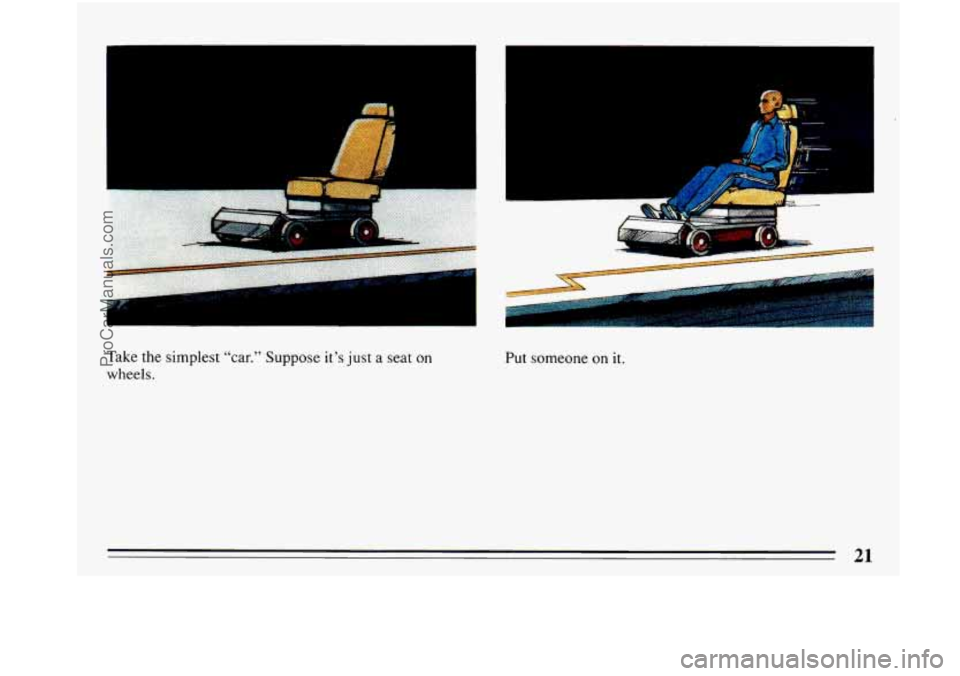
I
Take the simplest “car.” Suppose it’s just a seat on
wheels.
I
..
‘E
Put someone on it.
21
ProCarManuals.com
Page 38 of 340
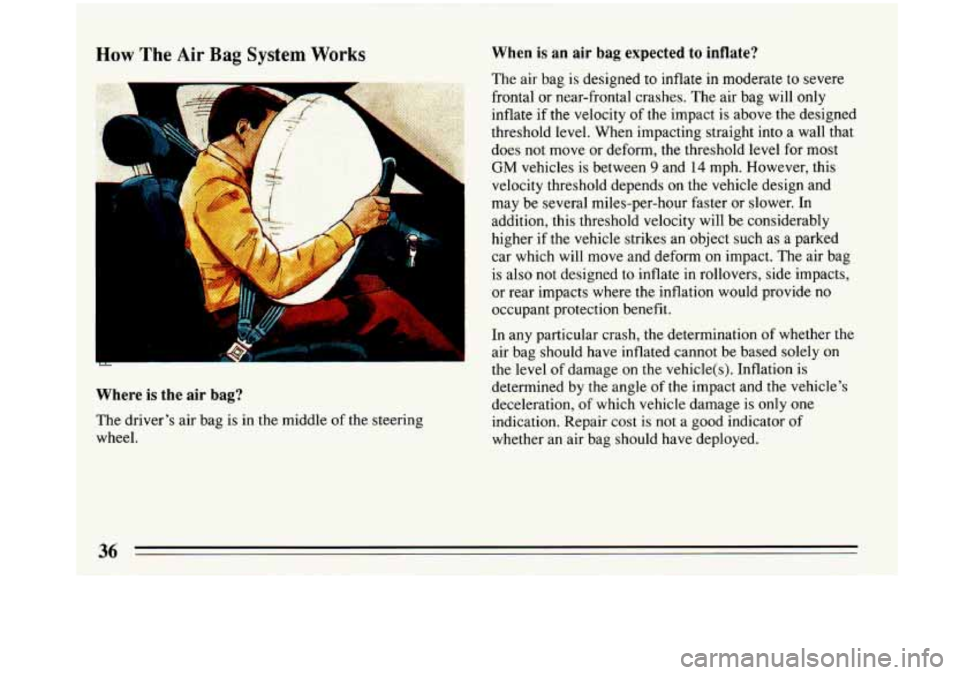
How The Air Bag System Works When is an air bag expected to inflate?
The air bag is designed to inflate in moderate to severe
frontal or near-frontal crashes. The air bag will only
inflate if the velocity
of the impact is above the designed
threshold level. When impacting straight into a wall that
does not move or deform, the threshold level for most
GM vehicles is between 9 and 14 mph. However, this
velocity threshold depends on the vehicle design and
may be several miles-per-hour faster or slower. In
addition, this threshold velocity will be considerably
higher if the vehicle strikes an object such as a parked
car which will move and deform on impact.
The air bag
is also not designed to inflate
in rollovers, side impacts,
or rear impacts where the inflation would provide
no
occupant protection benefit.
In any particular crash, the determination of whether the
, air bag should have inflated cannot be based solely on
the level of damage on the vehicle(s). Inflation is
Where is the air bag?
The driver's air bag is in the middle of the steering
wheel. determined
by the angle of the impact and the vehicle's
deceleration, of which vehicle damage is
only one
indication. Repair cost
is not a good indicator of
whether an air bag should have deployed.
ProCarManuals.com
Page 39 of 340
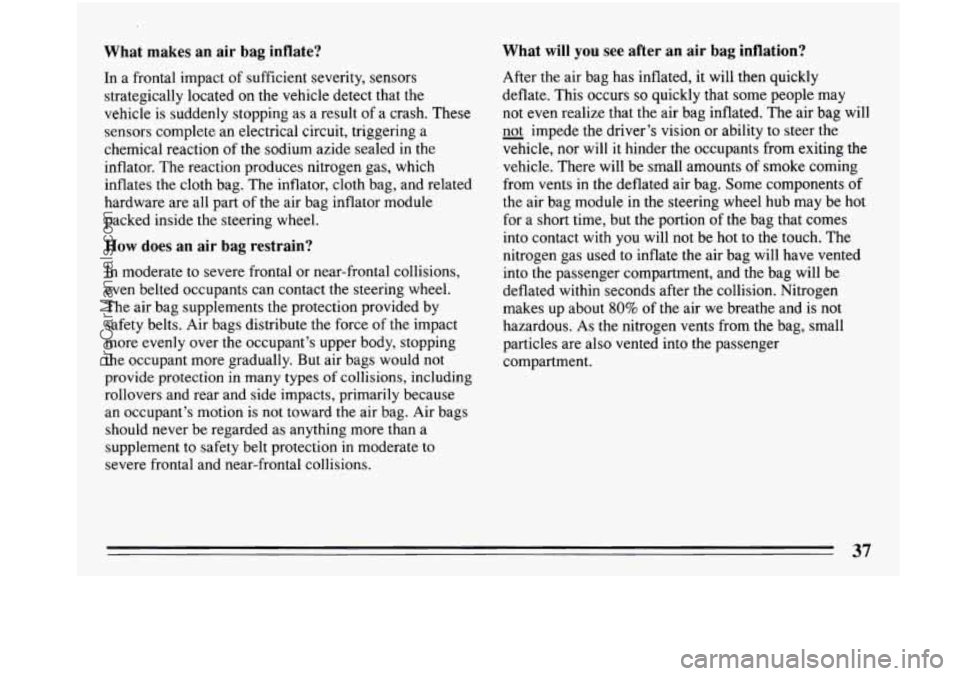
What makes an air bag inflate?
In a frontal impact of sufficient severity, sensors
strategically located
on the vehicle detect that the
vehicle is suddenly stopping as a result
of a crash. These
sensors complete an electrical circuit, triggering a
chemical reaction
of the sodium azide sealed in the
inflator. The reaction produces nitrogen gas, which
inflates the cloth bag. The inflator, cloth bag, and related
hardware are all part of the air bag inflator module
packed inside the steering wheel.
How does an air bag restrain?
In moderate to severe frontal or near-frontal collisions,
even belted occupants can contact the steering wheel.
The air bag supplements the protection provided by
safety belts. Air bags distribute the force
of the impact
more evenly over the occupant’s upper body, stopping
the occupant more gradually. But air bags would not
provide protection in many types
of collisions, including
rollovers and rear and side impacts, primarily because
an occupant’s motion is not toward the air bag. Air bags
should never be regarded as anything more than a
supplement
to safety belt protection in moderate to
severe frontal and near-frontal collisions.
What will you see after an air bag inflation?
After the air bag has inflated, it will then quickly
deflate. This
occurs so quickly that some people may
not even realize that the air bag inflated. The air bag will
- not impede the driver’s vision or ability to steer the
vehicle,
nor will it hinder the occupants from exiting the
vehicle. There will be small amounts
of smoke coming
from vents in the deflated air bag. Some components of
the air bag module in the steering wheel hub may be hot
for
a short time, but the portion of the bag that comes
into contact with you will not be hot to the touch. The
nitrogen gas used to inflate the air bag will have vented
into the passenger compartment, and the bag will be
deflated within seconds after the collision. Nitrogen
,makes up about
80% of the air we breathe and is not
hazardous. As the nitrogen vents from the bag, small
particles are also vented into the passenger
compartment.
37
ProCarManuals.com
Page 61 of 340

Part 2 Features & Controls
Here you can learn about the many standard and optional features on your Buick. and information on starting. shifting
and braking
. Also explained are the instrument panel and the warning systems that tell you if everything is working
properly
.. and what to do if you have a problem .
Keys ........................................................................\
.... 60
DoorLocks
....................................................................... \
62
NewVehicleBreak-In .............................................................. 74
StartingtheEngine ................................................................. 76
ShiftingtheTransaxle
.............................................................. 80
Windows ........................................................................\
. 90
TiltSteeringWheel
................................................................ 90
Multi-FunctionLever
............................................................... 91
TurnandLaneChangeSignals ................................................... 91
Headlight High-Low Beam Change Signals
......................................... 91
WindshieldWiper/Washer
...................................................... 94
CruiseControl ................................................................ 96
Instrumentpanel
................................................................... 116
Speedometer and Odometer
..................................................... 117
Warning Lights and Gages
...................................................... 117
59
~ .. . ~ .. .. _.__~ ....... - ...... ... ..._- .... -
ProCarManuals.com
Page 73 of 340

Theft
Vehicle theft is big business, especially in some cities.
Although your Buick has a number of theft deterrent
features, we know that nothing we put on
it can make it
impossible to steal. However, there are ways you can
help.
Kev in the ignition: If you walk away from your
vehicle with the keys inside, it’s an easy target for joy
riders or professional thieves
-- so don’t do it.
When you park your Buick and open the driver’s door,
you’ll hear a tone reminding you to remove your key
from
the ignition and take it with you. Always do this.
Your steering wheel will be locked, and
so will your
ignition and transaxle. And remember to lock the doors.
Parking at Night: Park in a lighted spot, close all
windows and lock your vehicle. Remember
to keep your
valuables
out of sight. Put them in a storage area, or take
them with you.
Parking. Lots: If you park
in a lot where someone will
be watching your vehicle, it’s best to lock
it up and take
your keys. But what if you have
to leave your ignition
key? What if you have to leave something valuable
in
your vehicle?
Put your valuables in a storage area, like your trunk
Lock the glove box.
or glove
box.
0 Lock all the doors except the driver’s.
0 Then take the door key with you.
Universal Theft Deterrent (Option)
If your Buick has this option, it has a theft deterrent
alarm system. With this system, the “SECURITY’’ light
will flash as
you open the door (if your ignition is off).
This light reminds you
to arm the theft deterrent system.
Here’s how to do it:
1. Open the door.
2. Lock the door with the power door lock switch or
Remote Keyless Entry System. The “SECURITY”
light should come on
and stay on.
3. Close all doors. The “SECURITY” light should go
off.
If a door or the trunk is opened without the key or
Remote Keyless Entry System, the alarm will
go off. It
will also
go off if a door lock or the trunk lock is
damaged. Your vehicle’s lights will flash and the horn
71
ProCarManuals.com
Page 77 of 340

Ignition Key Positions
Your square-headed key
operates your ignition lock.
ACC
1
I
This lock gives you five different positions.
Before
you put the key in, your ignition will be in the
“Lock” position. This position locks your ignition,
steering wheel and transaxle. It’s a
theft deterrent
feature.
The other positions let you perform these functions:
ACC: Accessory lets you use things like the radio and
the windshield wipers when the engine is off. To get into
“Acc”, push in the key and turn it toward
you. Your
ProCarManuals.com
Page 78 of 340
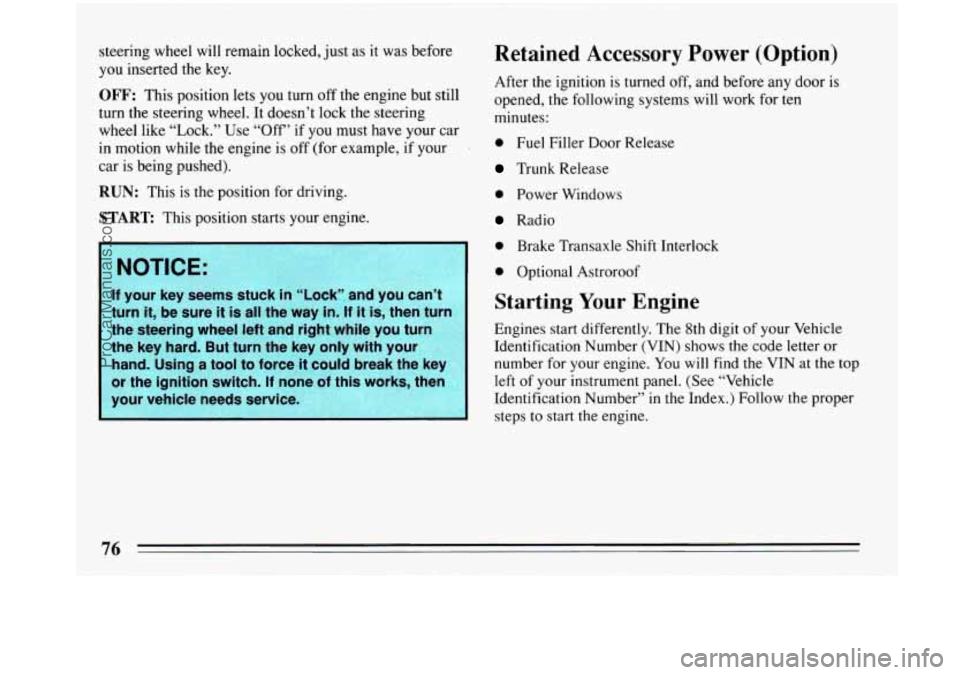
steering wheel will remain locked, just as it was before
you inserted the key.
OFF: This position lets you turn off the engine but still
turn the steering wheel.
It doesn’t lock the steering
wheel like “Lock.” Use “Off’ if
you must have your car
in motion while the engine is off (for example, if your
car is being pushed).
RUN: This is the position for driving.
START This position starts your engine.
NOTICE:
If your key seems stuck in “Lock” and you can’t
turn
it, be sure it is all the way in. If it is, then turn
the steering wheel left and right while you turn
the key hard. But turn the key only with your
hand. Using a tool to force
it could break the key
or the ignition switch. If none of this works, then
your vehicle needs service.
p’
Retained Accessory Power (Option)
After the ignition is turned off, and before any door is
opened, the following systems will work for ten
minutes:
0 Fuel Filler Door Release
Trunk Release
0 Power Windows
Radio
0 Brake Transaxle Shift Interlock
0 Optional Astroroof
Starting Your Engine
Engines start differently. The 8th digit of your Vehicle
Identification Number
(VIN) shows the code letter or
number for your engine. You will find the
VIN at the top
left of your instrument panel. (See “Vehicle
Identification Number” in the Index.) Follow the proper
steps to start the engine.
ProCarManuals.com
Page 82 of 340
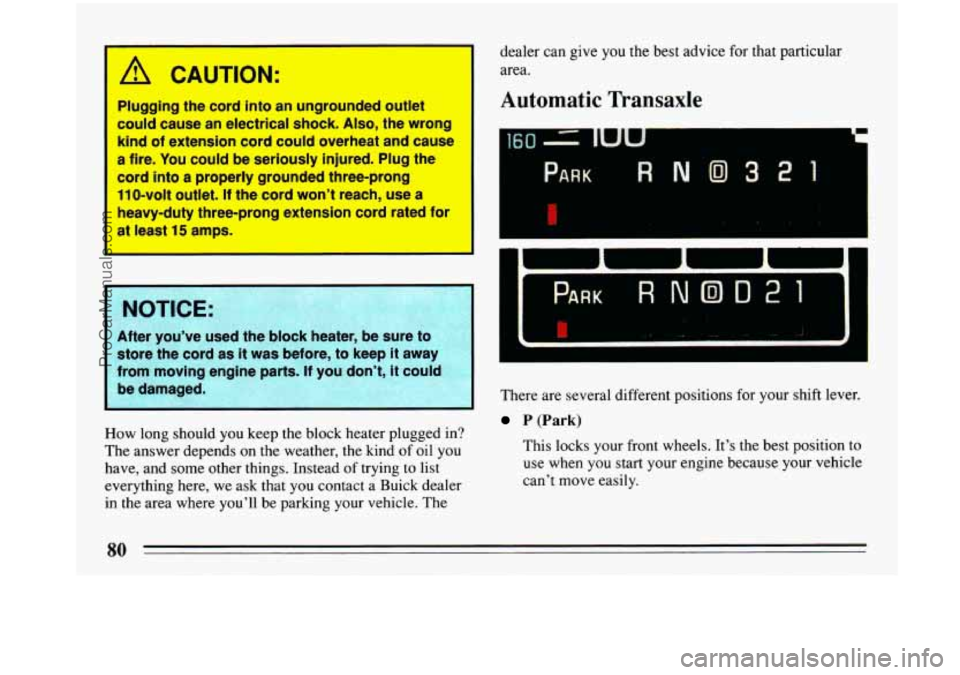
A CAUTION:
I
Plugging the cord into an ungrounded outlet
could cause an electrical shock.
Also, the wrong
kind of extension cord could overheat and cause
a fire. You could be seriously injured. Plug the
cord into a properly grounded three-prong
110-volt outlet. If the cord won’t reach, use
a
heavy-duty three-prong extension cord rated for
at least
15 amps.
I
I NOTICE:
After you’ve used the block heater, be sure to
store the cord as
it was before, to keep it away
from moving engine parts. If you
don’t, it could
be damaged.
1
I
How long should you keep the block heater plugged in?
The answer depends on the weather, the kind
of oil you
have, and some other things. Instead
of trying to list
everything here, we ask that
you contact a Buick dealer
in the area where you’ll be parking your vehicle. The dealer
can give you the
best advice for that particular
area.
Automatic Transaxle
160 - IULJ
PARK FINO321
i
b
PARK R N 0 D 2 1
There are several different positions for your shift lever.
P (Park)
This locks your front wheels. It’s the best position to
use when you start your engine because your vehicle
can’t move easily.
I
80
ProCarManuals.com